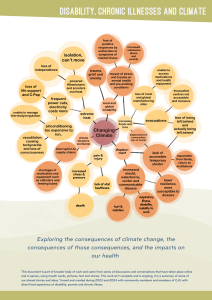1. Important to know before you start
Recognise Lived Experience expertise
Identifying climate injustice in the community begins with recognising that people are usually the experts in their own lives. Even though some of us may not realise how we are already and will continue to feel climate change and its impacts, we can work together to find out and get better prepared. Working together means CSOs having conversations and relationships with the community to better understand the lived experiences of extreme weather, disaster, and resilience and how these are compounded by other structural challenges and inequities.
To identify climate injustices in the community, it is also important to recognise that climate change does not affect every family or person in the same way. Climate change has an unequal impact because it intersects with historical and systemic oppression. Examples of oppressive systems include capitalism, which prioritises profit over people, and patriarchy, which undermines the rights of women and diverse genders. CSOs often have a strong grasp of how oppressive systems interconnect to make some people more vulnerable, marginalised and disadvantaged.
Connect with community via conversations, relationships, and advisory groups
It is essential that people who have lived experiences of climate impacts and social inequality are at the centre of conversations about climate injustice. These “Lived Experience communities” typically include Aboriginal and Torres Strait Islander peoples, women and gender diverse people, culturally and linguistically diverse people, young and elderly people, and people with disability, among other communities. CSOs should work respectfully with Lived Experience communities to understand climate injustice. This work requires building strong, trusted relationships with the community (clients/customers) and establishing a Lived Experience Advisory Group and/or Aboriginal Advisory Group.. This involvement ensures that power is handed over to the community, allowing them to guide the climate justice work.
Continually practise respectful, trustful, and careful relationships
By actively listening and respectively acting on the insights from Aboriginal and Torres Strait Islander peoples, people with Lived Experience and community members, you reinforce procedural justice—ensuring fairness in decision-making processes. In doing so, you support a reciprocal relationship that values diverse knowledges and lived experiences, fostering genuine collaboration and shared responsibility in addressing climate justice and resilience.
2. Collective Learning: Climate injustices in WAs local communities (preparation)
Use the below material and pre-readings with your team/community to prepare and learn more about climate risks and the diverse impacts of climate on you and on already existing social injustices in your region. You may consider delegating topics to team members to share back to the groups in a “lunch and learn” style or assign all the topics as pre-reading before a meeting or designated workshop.
See the section Who should be involved to better understand who should be involved in discussions, learning, workshops and decision-making.
- See section 3 to learn how to engage the community.
a. Pre-readings
- Learn about climate risks in your region.
The Understanding and Preparing for Different Climate Events resource will help you assess climate risks in your region.
- Learn about the climate impact on health.
Use the Health and Climate Change resource.
- Learn about the diverse and intersectional climate impacts on your community and the people you are working with.
The Climate Impacts on Social Injustices & Intersectionality resource will help to better understand how climate change affects people differently and get a better understanding of cumulative climate injustices.
- Learn about climate impacts on emotions, wellbeing and mental health.
The resource Climate Emotions provides insights into how people in your community might experience the impacts of climate change on their well-being, emotions and mental health.
- Learn about the dimensions of climate justice
In the resources What is climate justice? you will find a table that reflects and explains the various dimensions of climate justice. There will also be a set of questions that will help you reflect on each dimension and how it is integrated within the organisation.
b. Reflective questions and workshop
The below questions are designed to encourage discussions within your team and lay the groundwork for meaningful action. They can be integrated into a dedicated workshop.
Use what you learned from the previous section and the resources to collectively answer the questions below.
The following key questions can be used for CSOs to start their journey to better understanding climate injustices in their community:
- What are the predicted climate impacts in our region?
- What are/will be the health impacts of climate change in our community?
- Who is most affected by climate impacts in our community? Are there specific groups, such as low-income families, people of colour, or those with disabilities, facing more severe effects?
- How does climate change impact emotions, well-being, and mental health?
Consider:
- How is environmental harm distributed across different neighbourhoods? Which areas experience higher levels of pollution, flooding, or heat?
- What are the barriers to accessing clean water, safe housing, food, and green spaces? Do these barriers disproportionately impact certain groups?
- How do existing systems of oppression, like racism, capitalism and patriarchy, contribute to climate injustice? In what ways do these systems prioritise profit or certain groups over others?
- Are community members who are most affected by climate justice decisions included in decision-making processes? How can we ensure that systemically marginalised voices are heard and valued and that our organisation is taking action based on those voices?
- Is there transparency in how climate policies are created and implemented? Are the processes open and clear to everyone in the community?
- How can CSOs contribute to climate resilience? What specific needs do specific groups have, and how can they be addressed?
- How can we incorporate reflexivity into our approach to climate justice? Are we aware of our own biases and roles in perpetuating injustice, and how can we change them?
You can use the following template to develop and document your responses: “Learning about climate injustices in our community”
You can also use a consequence wheel like the example below to explore the impacts of climate on social injustices in your local community.
(Source: Climate Change, Disability and Chronic Illness)
c. Additional resources that can help inform learning and workshops
Use the Climate Justice Audit Tool to strengthen your reflection and assessment.
Find further questions in this resource: Lens of Systemic Oppression.
Additional Questions adapted from Intersectionality Based Policy Analysis of How Racism is Framed in Medical Education Policies Guiding Aboriginal Health Curriculum include:
- What are the inequities affecting the community members you are working with?
- Which actions are in place to address climate injustices?
- Which other feasible solutions need to be proposed?
- How will the policy responses reduce climate injustices?
- How will implementation and uptake be assured?
- How will it be known that climate injustices are reduced?
3. Engage with community to identify climate injustices
Identifying climate injustices in your community is an important step in addressing how climate change impacts marginalised groups. These injustices often deepen existing social inequalities. To assess the specific ways in which climate change impacts their community, it is important to use principles of recognitional justice. Engaging directly with communities is key. According to the report Community-led responses to climate change: discovering conditions for equity and social justice, community-led responses are most effective when those who are directly affected are included in decision-making. For example, Aboriginal and Torres Strait Islander peoples bring valuable knowledge about living with and caring for Country. Involving communities in climate action ensures that responses are not only inclusive but also culturally informed and more sustainable.
Furthermore, it outlines the importance of distinguishing between less participatory and more shared power forms of community engagement.
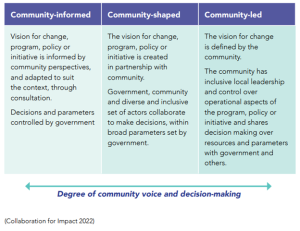
(Source: Community-led responses to climate change)
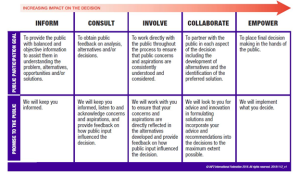
(Source: International Association for Public Participation Australia)
The South Coast Natural Resource Management and AIDR Community Engagement handbooks emphasise the importance of listening and then acting on what is shared by the community. Use approaches like yarning, community consultations, and co-design to understand the specific climate injustices faced by your community. These processes ensure that responses are transparent and grounded in the real-life experiences of those most affected. Climate justice requires Collaboration for Impact.
Important Resources:
- Processes of Lived Experiences Engagement
- Engaging Aboriginal and Torres Strait Islander peoples
- Community-led disaster preparedness
4. Engagement methods
You can use a variety of strategies and methods to gather climate justice impact information from your community.
- Focus Group Yarns
- Interviews
- Arts-based methods
The Climate Resilience Toolkit: Art-based activities for changing climates
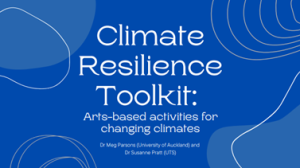
The Climate Resilience Toolkit: Art-based activities for changing climates offer a fresh approach to talking about and dealing with climate change and its effects. It lets people think about and picture being ready for climate changes, fairness in dealing with climate issues, and adjusting to them, using various forms of art.
These tools are just the beginning of a team’s efforts to use art to help people understand, get involved in, and make real changes for fairness, readiness, and adjustment to climate changes. They’re made to be used and changed to suit different places and groups of people.
The toolkit is made up of different activities, each meant to get people thinking about and acting on different parts of getting ready for climate changes. They focus on hope, giving power to people, and working together. Some of the activities are:
Adaptation Paths: A Climate Change Journey: This is a group project where people make art to show their journey from knowing about climate changes to doing something about them.
United We Stand: Clay Figurines of Community Resilience: This activity uses clay figures to show how each person helps make their community strong against climate changes.
Theatre of the Resilient: This activity, inspired by a type of theatre called the Theatre of the Oppressed, lets people act out power struggles and be ready for climate changes using interactive theatre and AI-generated scripts.
Read more
Creative responses – (youth)
The Creative Recovery Network collaborates with the creative sector – individual artists, arts workers, and arts organisations – to support the ongoing activation of creative programs in disaster preparedness, response and recovery.
Gender and Disaster Australia (GADAus), Addressing the harmful impacts of gender stereotypes in disaster.
We aren’t all equal when it comes to climate vulnerability. An interactive map where you can check your area’s vulnerability to climate.
Climate Council Heat Map: An interactive map where you can check how hot your area may get without climate action.
ACOSS – Blueprint Framework for Fair, Fast, and Inclusive Climate Change Action
